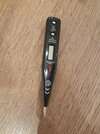- Joined
- 14 Feb 2005
- Messages
- 102
- Reaction score
- 16
- Country

Hi all,
We just put a bracket up for a light fitting on our ceiling. The ceiling is thick plaster sheets hung on long screws I think (I.e. there are no battens behind, in the void you see right across and it is just punctuated with metal "screws" or "posts").
We generally have hooks in our ceiling fittings that are attached to the actual concrete ceiling above, but not here.
We checked for wires and metal "screws" then drilled. When I put the tension testing screwdriver (the light up one) against the bracket I get nothing. When I put the tension checking device against it (picture below) it shows the symbol for tension being present.
is it possible that we touched a wire in the void? With a dull ended drill bit? The wires are loose so they would normally just have moved and anyway there shouldn't have been any where we drilled. We were limited in where to put it as the detector was showing the metal posts and wires elsewhere.
Should we worry at this point?
Thank you all!
We just put a bracket up for a light fitting on our ceiling. The ceiling is thick plaster sheets hung on long screws I think (I.e. there are no battens behind, in the void you see right across and it is just punctuated with metal "screws" or "posts").
We generally have hooks in our ceiling fittings that are attached to the actual concrete ceiling above, but not here.
We checked for wires and metal "screws" then drilled. When I put the tension testing screwdriver (the light up one) against the bracket I get nothing. When I put the tension checking device against it (picture below) it shows the symbol for tension being present.
is it possible that we touched a wire in the void? With a dull ended drill bit? The wires are loose so they would normally just have moved and anyway there shouldn't have been any where we drilled. We were limited in where to put it as the detector was showing the metal posts and wires elsewhere.
Should we worry at this point?
Thank you all!



